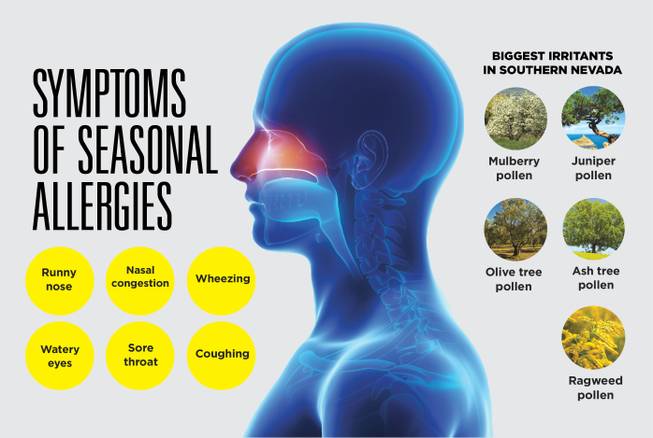
Sunday, March 22, 2015 | 2 a.m.
It’s finally spring.
Flowers are blooming, cool breezes are blowing, and the heat hasn’t yet reached its peak. Yep, springtime in the desert is undeniably beautiful.
But for many of us who suffer from seasonal allergies, this time of year also can bring a lot of unwelcome and unpleasant symptoms.
“All patients have different allergy months that trigger (symptoms), but classically, it’s the spring months — now through May,” said Dr. Terrance Kwiatkowski, MD, of Sunrise Hospital and Medical Center. “In Las Vegas, I’d say that March and April tend to be the height of allergy season for many people.”
Though we often associate environmental allergies with specific allergens, some people simply are sensitive to irritants in the air such as dirt, debris, dust and pollutants. “Some patients will test negative to everything during allergy testing and are just reacting to the irritants blowing around,” Kwiatkowski said.
Symptoms of seasonal allergies
• Runny nose
• Nasal congestion
• Wheezing
• Watery eyes
• Sore throat
• Coughing
Biggest irritants in Southern Nevada
• Mulberry pollen
• Juniper pollen
• Olive tree pollen
• Ash tree pollen
• Ragweed pollen
A dry climate exacerbates irritation
The dryness in Las Vegas also can pose a hurdle for allergy patients.
“A dry climate like this can really exacerbate allergy symptoms,” Kwiatkowski said. “The natural mechanism of the nose and throat is to secrete mucus to clean out the allergens before they take hold and cause a reaction, and that whole system just works better in moist environments. Our bodies have a harder time defending against allergens in dry climates because we’re often not producing as much mucus to flush out the bad stuff.”
Treating your allergies
• Antihistamines (Benadryl, Zyrtec, Claritin)
These inhibit the action of histamines that are released during an allergic reaction by blocking histamine receptors. They stop inflammation. Dr. Terrance Kwiatkowski recommends these as the first line of allergy treatment but warns that antihistamines can make some people very drowsy. Opt for the nonsedating brands to be safe.
• Steroid nasal spray (Flonase, Nasonex, Rhinocort)
These act as a powerful anti-inflammatory agents, decreasing inflammation in the nasal passageways to quell symptoms. They generally are available only by prescription, although over-the-counter options are beginning to hit the market.
If the above options don’t work, consider...
• Montelukast
A prescription oral pill, helps reduce inflammation and is a good complementary treatment to antihistamines.
• Patanase
A prescription antihistamine nasal spray, localizes the antihistamine and is a good complementary treatment to steroid nasal spray.
• Dymista
A prescription steroid and antihistamine nasal spray, works very well on its own, but many insurance companies don’t cover it.
• Allergy shots
Some people get steroid shots to help eliminate inflammation for an extended period of time. Some people go to allergists for allergy testing, which means identifying individual allergens by pinprick testing (exposing patients to different allergens to see which ones cause a reaction), then treating them through continued low-dose exposure to trouble allergens until immunity develops. However, this does not work for everyone.
“Immunotherapy is extremely effective in some people and does nothing for others,” Kwiatkowski said. “It’s not entirely understood why yet.”
Kwiatkowski recommends that anyone experiencing allergies start with an over-the-counter antihistamine. If that doesn’t work, the patient should see his or her doctor to discuss prescription options.
Surgery options
For people who suffer from severe allergies, acute congestion, sinus infections or facial pain and pressure, chronic sinusitis may be to blame.
The condition often requires surgery, but that surgery typically can be performed as a minimally-invasive outpatient procedure called balloon sinuplasty. During the procedure, a tiny balloon is guided into the sinus opening, then inflated. That dilates and unclogs the opening, allowing fluid to drain and offering the patient immediate relief.
“What you’ve done is remodeled the sinus opening, and it will stay that way once you remove the balloon because the bone will heal in the position you left it,” Dr. Terrance Kwiatkowski said.
The procedure, which takes 20 to 45 minutes, can be performed in a doctor’s office, without any downtime for the patient.
“This procedure is game changing for patients who wake up multiple times a week with sinus headaches,” Kwiatkowski said.

Join the Discussion:
Check this out for a full explanation of our conversion to the LiveFyre commenting system and instructions on how to sign up for an account.
Full comments policy